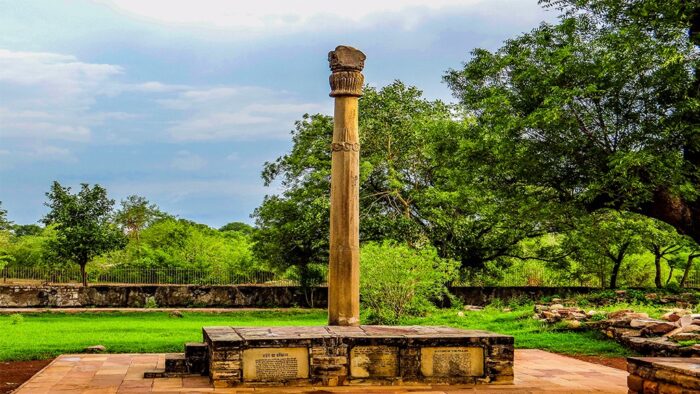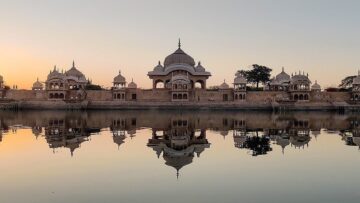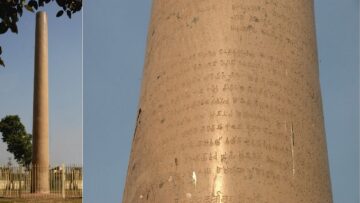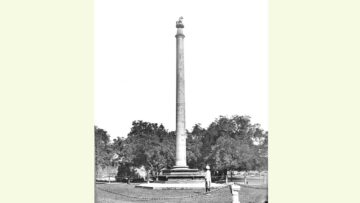Bhagavān Vāsudeva Kṛṣṇa has received a sustained followership in Sanātana Dharma since time immemorial and is justifiably considered to be one of the most venerated and popular Gods of all time.. Texts like the Mahābhārata, Harivaṁśa, Viṣṇu Purāṇa, Bhāgavata Purāṇa, Padma Purāṇa and Garga Saṁhitā recount the magnificence of his life, his virtues and his glories. Over the years these legends became strongly embedded in the psyche of the followers of Sanātana Dharma. It is indeed noteworthy that the devotees of Bhagavān Vāsudeva Kṛṣṇa are not just restricted to India but he has found a wide devotee base among the global populations as well. Many modern Vaiṣṇava organisations have a large number of Indian and International devotees. Though these Vaiṣṇava organisations are recent, i.e. most of them were founded in the 20th century it is interesting to note that there were non-Indians who became devotees of Bhagavān Vāsudeva Kṛṣṇa more than two millennia ago. One such devotee was Heliodorus, a Greek Ambassador who visited the Vidiśā region of India in the 2nd century BCE. Heliodorus erected a Garuḍadhvaja in the honour of God Vāsudeva, i.e. Kṛṣṇa and became a follower of the Bhāgavata Sect. In this article, we will be discussing the inscription found on this Garuḍadhvaja. The Besnagar Garuḍadhvaja Pillar was discovered by Alexander Cunningham. It was covered with a thick coat of vermilion and the locals worshipped it as Khambā Bābā. Cunningham could not find any traces of an inscription on the pillar because of the vermilion cover. Another Garuḍadhvaja was found in the vicinity of the one under consideration. It was donated by one Gautamaputra who called himself a Bhāgavata i.e. a follower of Vāsudeva and he had erected this column when the king Bhāgavata had completed twelve years of his reign. Apart from the Garuḍadhvajas, a Palm Capital (Tāladhvaja) and a Crocodile Capital (Makaradhvaja) were also discovered at Besanagar. The Palm Capital is the insignia of Saṃkarṣaṇa or Balarāma and the Crocodile Capital belongs to Pradyumna. These archaeological remains indicate that Besnagar must have been a centre of the Vaiṣṇava Pāñcarātra or Bhāgavata sect. Remains of Buddhist, Jaina and Hindu temples were also unearthed at Besnagar when the site was excavated in the early 1900s. This clearly points to the fact that Besnagar was an important religious centre during the reign of the Suṅgas.
Pāṇini, the great grammararian mentions the name Vāsudeva in one of his sūtras. Pāṇini is considered to have lived in the 5th-4th centuries BCE. Patañjali, while commenting on this Pāṇinian sūtra states that Vāsudeva is not the name of a Kṣatriya but of a God (Chari, 2000: 22). It can be said that long before we had inscriptions mentioning the deity Vāsudeva, the Bhāgavata Sect centering round Vāsudeva as the supreme being had been established (Ibid). Evidence going back to the 2nd century BCE about the existence of the Bhāgavata Cult comes from the Dvādaśāditya Mound in Vṛndāvana. There, a few large sized bricks were discovered which carry the names of Naṭaka and Gomitra, both of whom are called Bhāgavatas and were perhaps donating something to a Bhāgavata shrine at the site. The Ghosuṇḍi Inscription from Rajasthan mentions the building of a surrounding wall (pujā śīlā prākāra) around the hall of worship of the Saṃkarṣaṇa and Vāsudeva. This inscription is datable to the 2nd century BCE. The Nāṇeghāṭ Inscription of the Sātavāhana queen, Nāganikā, invokes Saṃkarṣaṇa and Vāsudeva along with Vaidika deities and this inscription can be dated to the 1st century BCE. In the opinion of Chari, the reference to the names of both Saṃkarṣaṇa and Vāsudeva suggests the existence of the Pāñcarātra System (perhaps the most ancient form of Vaiṣṇavism) (Ibid). Vāsudeva or Para Vāsudeva is the highest Vyuha in the Pāñcarātra System and Saṃkarṣaṇa originates from him. Thus the roots of the worship of Vāsudeva alone and along with Saṃkarṣaṇa indeed go back to the remote past. The Mora Well Inscription from Mathurā records the construction of a stone temple for the installation of the Pañca Vṛṣṇi Vīras by a lady called Toṣā. This inscription is dated to the 1st century CE. These five heroes have been rightly identified by J.N. Bannerjea as Vāsudeva, Saṃkarṣaṇa, Pradyumna, Sāmba and Aniruddha who were the scions of the Vṛṣṇi family and closely related to each other. Except Sāmba, the other four acquired the position of the Vyuhas of the Pāñcarātra System. Another inscription at Mathurā records the donation of a toraṇa (gateway) and a vedikā (railing) by a person called Vasu to the temple of God Vāsudeva which was known as Vāsudeva Mahāsthāna. We can thus say, on the basis of inscriptions that the Bhāgavata Sect was deeply entrenched in the Indian society two millennia ago.
Now coming to the Besnagar Pillar Inscription of Heliodorus, it was brought to the notice of John H. Marshall, the then Director General of Archaeology. The inscription has been written in the Brāhmī script and the language is Prākṛt. The first account of this inscription appeared in the Journal, Royal Asiatic Society in October 1909 where the transcript and transliteration of the inscription by T. Bloch were also published. A better transliteration and article by Dr. Fleet followed the one given by Bloch. The present article is based on the one authored by D.R. Bhandarkar where he has presented his own transliteration, translation and additional explanation of the inscription. The inscription is not a very long one and has eight lines. The object of the inscription was to record the erection of a Garuḍadhvaja in the honour of the God Vāsudeva by the Greek ambassador (Yona i.e. Yavana Dūta) named Heliodorus who was representing the Indo-Greek king, Antalkidas in the court of the king or crown prince Kosīputra Bhāgabhadra. As per the inscription, Heliodorus was a resident of the city of Takṣaśīlā, which was one of the major cities of ancient India. Heliodorus is called a Yona i.e. Yavana and this helped in establishing his Greek ethnicity.
The translation of the inscription given by D.R. Bhandarkar is as follows:
The Garuḍdhavaja of Vāsudeva, the God of Gods (Devadeva) was caused to be made here, for instructions in (his) new religion by Heliodora, a Bhāgavata, son of Diya, a native of Takṣaśīlā, a Yavana ambassador coming from the great king Aṁtalikita to Kautisiputra Bhāgabhadra , the savior (and) residing in the country of Nai in the middle country i.e. Madhya Deśa.
Heliodorus was sent to the court of Kautisīputra (or Kosiputra) Bhāgabhadra who ruled Vidiśā in the Madhyadeśa by the king Antalkidas. Vidiśā is identified with Besnagar. There is a high possibility that Heliodorus came in contact with the Bhāgavata Sect when he visited the court of Bhāgabhadra. However, we need to take another point into consideration. In the 1970s, a few coins of the Indo-Greek king Agathocles, who ruled in the 2nd century BCE, were discovered at Ai Khanoum in modern day Afghanistan. These coins had on them the images of Vāsudeva-Kṛṣṇa and Saṃkarṣaṇa-Balarāma. The presence of these images indicates that perhaps the Bhāgavata sect had spread up to Ai Khanoum by the 2nd century BCE and perhaps Agathocles himself was a follower of the Bhāgavata Sect. So we may assume that Heliodorus may have encountered this sect in his homeland Takṣaśīlā itself and his faith in the Bhāgavata sect may have been strengthened during his residence at Vidiśā and he may have imbibed the tenets of this sect here. He had the Garuḍadhvaja erected for the propagation of the new religion that he had begun to profess. Vidiśā may have had a well-established settlement of Bhāgavata followers. However, this is just a conjecture from our side and cannot be taken as a proven fact. Another fact which should be duly considered is that, as D.R. Bhandarkar points out, the teachings of the Bhāgavata sect also got inscribed on this pillar by Heliodorus which are found on the other side of the pillar. However, one fact that is crystal clear is that Heliodorus had become a Bhāgavata himself. Another point worth asserting is that the Bhāgavata Sect must have been an open sect, which admitted even foreigners within its fold. Heliodorus’ coming to Vidiśā indicates some kind of diplomatic relations between Antalkidas and Bhāgabhadra.
D.R. Bhandarkar brings forth the point that a king called Bhāgavata features as the ninth king in the list of Śuṅga rulers given in the Puraṇas. He comments that the name Bhāgavata may be a crude form of the name Bhāgabhadra (Bhandarkar, 1969: 106). The names of individual kings appear in different forms in the genealogies of the Purāṇas and actual inscriptions. He further suggests that Bhāgabhadra may have been the Śuṅga yuvarāja who was stationed at Vidiśā in a manner similar to his ancestor Agnimitra, who as per Kālidāsa ̍s play Mālavikāgnimitram, was based in Vidiśā (Ibid). Though he might have been the crown prince, Bhāgabhadra must have commanded proper authority since the Indo-Greek king thought it appropriate to send an ambassador to his court. The other Garuḍadhvaja found at Besnagar mentions a king called Bhāgavata ruling in his twelfth regnal year and this has made a few scholars cast doubts on Bhandarkar’s identification. Some scholars have tried to argue that Bhāgabhadra should be identified with the fifth Suṅga ruler who is variously called as Odraka, Andhraka and Bhadraka. A.K. Narain does not agree with this identification. In his opinion, the names Bhāgabhadra and Bhāgavata found on the two Garuḍadhvajas from Besnagar are the names of the one and the same king who ruled for thirty-two years (Narain, 1957: 120).
Antakildas, one of the well known later Indo-Greek kings came to power when the family of Eucratides I was in a state of decline. Antakildas is credited for retrieving the lost fortunes of his family around 115 BCE. He issued a variety of coins and along with Menander, is the only
Indo-Greek king to be mentioned in an Indian source i.e. the Besnagar Pillar Inscription. Antakildas was overthrown at Takṣaśīlā in 100 BCE by Apollodotus.
Coming back again to Bhāgabhadra, he has been referred to as ̍ Trātāra ̍ which is the counterpart of the Greek ̍Soter ̍.In the opinion of A.K. Narain, this is not a common epithet of an Indian king and this title must have been accorded to him by Heliodorus (Narain, 1957: 120). He further states that it is rather surprising as to why Heliodorus chose this title as it was not used by Antakildas or his forerunners (Ibid). In the opinion of Narain, in the last stage of his rule, Antakildas ̍s territory was only limited to Takṣaśīlā and he may sought help from Bhāgabhadra and sent his envoy to the latter ̍s court. We do not know what the outcome of this diplomatic mission was, but Antakildas was soon ousted from his kingdom.
The Besnagar Pillar Inscription of Heliodorus thus sheds valuable light on the history of the Bhāgavata Sect in India. By the 2nd century BCE, the Bhāgavata Sect was a well established one with its chief votary Vāsudeva. Besnagar, as we have mentioned before must have certainly been a prominent centre of the Bhāgavata or the Pāñcarātra Sect. The worship of Vāsudeva as the principal God of the Bhāgavatas had gained currency by the Suṅga period. This sect attracted patronage from Indians and foreigners alike. We have also noted the fact that the Bhāgavata Sect must have been an open sect as it gave admission to a Yavana like Heliodorus. Heliodorus, as the inscription indicates, not only became a Bhāgavata but was also instrumental in proliferating its teachings. It is very much plausible that there must have been a temple dedicated to Vāsudeva near the Garuḍadhvaja along with temples dedicated to Saṃkarṣaṇa and Pradyumna. It should be noted that this was the time when Buddhism had become the principal religion of India with Buddhist establishments springing up throughout the country. The Besnagar Pillar Inscription of Heliodorus helps us in understanding the details of other sects like the Bhāgavata Sect prevalent in India at that time. It is indeed possible that the Suṅga king Bhāgabhadra may have patronised the Bhāgavata establishment at Besnagar. Bhāgabhadra was definitely a man of power and authority since an Indo-Greek king from the north western part of South Asia sent an embassy to his court, though it is difficult to ascertain its exact nature. Thus the Besnagar Pillar Inscription of Heliodorus is an important historical document that sheds valuable light on the religious and political life of ancient India.
References:
- Bhandarkar, D.R. 1969 (Reprint). “The New Besnagar Inscription”. The Journal of the Bombay Branch of the Royal Asiatic Society. Volume XXIII: 104-106.
- Chari, Srinivasa S.M. Vaisnavism: Its Philosophy, Theology and Religious Discipline. Delhi: Motilal Banrasidass Pvt. Ltd., 1994 (First Edition), 2000 (Reprint).
- Nagarkar, Sneha. 2020. “Temples in Ancient Mathura through Inscriptions”. Unpublished Paper.
- Narain, A.K. The Indo-Greeks. London: Oxford University Press, 1957.
Featured Image: livehistoryindia.com
Disclaimer: The opinions expressed in this article belong to the author. Indic Today is neither responsible nor liable for the accuracy, completeness, suitability, or validity of any information in the article.










